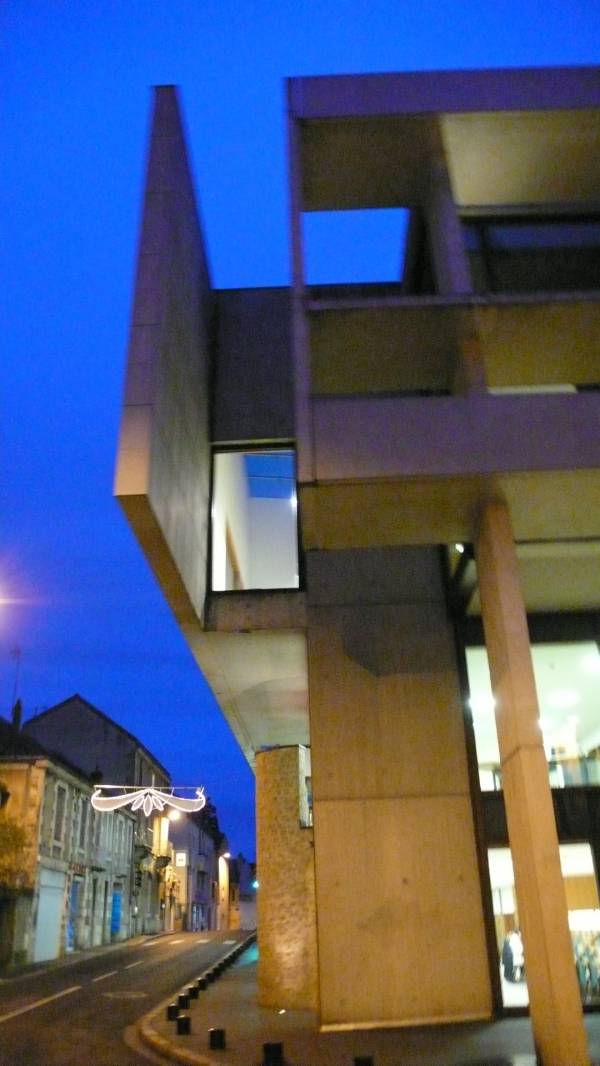May , 2003
不負責設計講座 (一)

續三月號勞頓的序言
撰文/黃鵬霖
設計架構的瘋狂理解
綜觀時下島內抄襲主流的結構設計,或是煞有介事的數位建築,時興的原素和線條,在深究的看門道之下,不難看出其設計原理的事後諸葛,好似大夥都私淑萊特,一脈相承 ; 反覆顧盼,又令人覺得像極了期未考作業。
歸根結底來思考,學院的原理原則,似乎全然未反映至實務面。更甚則背道而馳,讓人覺得是工業化的八股文充滿了華麗辭藻的裝飾面,但內容都空洞的言不及義,辭溢於情。也像是騷又像是詞,長篇大論,情愛、愛情、情情、愛愛 ; 如果是敘事或情境描寫深刻也就罷了…。
端正如此八點檔的設計架構,讓我們簡要分析一下學院理論的實務面,便容易回到設計的原點。
設計架構的原理界定
當 一個設計發想產生之前,審美的基礎及實用的量化絕對是創意的先行。設計終究是一門商業藝術,前述比例熟輕熟重攸關風格,但兩者絕對是思考的第一要務。少了 實用的量化,雜誌便成了攝影集,照明便成水晶主燈 ; 簡單的說,雜誌的內容恐怕比美編來得要緊 ; 照明的色溫、照度及演色性似乎也比燈具本身的造形更需要檢討。但至於審美和實用的比重,就不在本文討論的範圍了。而比重雖然恐怕主觀,但順序絕對是客觀 的。一切審美的基礎,皆應行於實用的量化之後,因為設計畢竟是一門商業藝術,再如何經過加持的大師皆不能超脫實用於度外。
實用的量化
單 純的說,無論設計產品的形式為何,先行的檢討都脫離不了三個要件,也就是使用者 (User)、機能 (Function)以及環境 (Environment),少了三者的量化,呈現出的設計架構完成面,便屬純藝術的範疇,而不能再被視為是設計品了。且利用這難得的無的放矢簡單的說 說。
一. 使用者
使用者角色的檢討絕對是一個設計產生的原始核心價值。市場 (Marketing)、標的屬性 (Target)、群組分析 (Group analysis)是這個項目構成的主要依據,也是設計初期的客觀判斷。
二. 機能
在設計手段的基本論述上,機能是實用量化的最要緊原則,也是設計品產生的過程中最科學的一環。先需要檢討相當程度的工業化技術,也就是人因基礎 (Human engineering),以及複合機能 (Composite function),來達到機能延伸或機能簡化的設計目的。其後,才是瞭解材料特性,以及利用材料特性來討論機能。
三. 環境
環境和使用者的依存關係往往被設計者輕易忽略,而不斷經營設計品本身。環境的幾何關係畢竟不能單獨存在,細微如平面和立面材料的串聯以及機能的結合等,擴大至使用環境中,每個分子之間相對關係的檢討。然而,環境構成的三大要素不外乎平面(Layout)、3D特性(3D Space)、動線檢討(經濟和自然地理)等。
審美的基礎
談 到審美,不由自主的又想打一番高空。常聽到從業同仁們私下大肆?伐令人嗤之以鼻的勞力士業主(當然,這批爺們現大多淪陷於五光十色的十里洋場),但如果審 美真是如此主觀的情人眼裡盡西施,那麼學院的審美論述價值何存?就是說,天賦已經決定一切,吾人又何需枉費青春,接受學術教育的養成與訓練呢?而黃金比例 若亦屬自由心證,其在乎數學及美學的背景又有何依據?亦則,科班課表中的”美學”及”造形”等學分,應該當時大多是在自習課或校外教學渡過便是了吧。我們 且將理論的審美概分為下列諸端,供業界諸公執行設計時臨摩謄抄之際,尚對我們偉大的業主有個說法,午夜夢迴時心理上也小有個慰藉。
一. 造形線條
綜觀造形線條無論具象與否,大多源取於原素的抽離,概 仿生或幾何、復古或形意。不動腦的精準如達芬奇的拷貝眼、或狂下線板大啖文藝復興(蓋”新古典”也)。 而高竿的如老祖宗的飛簷、浪漫仿古而科幻的法藍西龐畢度。
二. 比例
無論是幾近八股的對稱或偏斜到恐怕如編排出血,在同一個設計案中,由數大至毫微, 所構成的比例通常皆依循於同一個原理原則之下(忘了是哪一個哪一本的說法), 而比例的重覆或延伸,也被廣泛的使用於工業化的後現代思潮中。待續……….
不負責設計講座 (一)

續三月號勞頓的序言
撰文/黃鵬霖
設計架構的瘋狂理解
綜觀時下島內抄襲主流的結構設計,或是煞有介事的數位建築,時興的原素和線條,在深究的看門道之下,不難看出其設計原理的事後諸葛,好似大夥都私淑萊特,一脈相承 ; 反覆顧盼,又令人覺得像極了期未考作業。
歸根結底來思考,學院的原理原則,似乎全然未反映至實務面。更甚則背道而馳,讓人覺得是工業化的八股文充滿了華麗辭藻的裝飾面,但內容都空洞的言不及義,辭溢於情。也像是騷又像是詞,長篇大論,情愛、愛情、情情、愛愛 ; 如果是敘事或情境描寫深刻也就罷了…。
端正如此八點檔的設計架構,讓我們簡要分析一下學院理論的實務面,便容易回到設計的原點。
設計架構的原理界定
當 一個設計發想產生之前,審美的基礎及實用的量化絕對是創意的先行。設計終究是一門商業藝術,前述比例熟輕熟重攸關風格,但兩者絕對是思考的第一要務。少了 實用的量化,雜誌便成了攝影集,照明便成水晶主燈 ; 簡單的說,雜誌的內容恐怕比美編來得要緊 ; 照明的色溫、照度及演色性似乎也比燈具本身的造形更需要檢討。但至於審美和實用的比重,就不在本文討論的範圍了。而比重雖然恐怕主觀,但順序絕對是客觀 的。一切審美的基礎,皆應行於實用的量化之後,因為設計畢竟是一門商業藝術,再如何經過加持的大師皆不能超脫實用於度外。
實用的量化
單 純的說,無論設計產品的形式為何,先行的檢討都脫離不了三個要件,也就是使用者 (User)、機能 (Function)以及環境 (Environment),少了三者的量化,呈現出的設計架構完成面,便屬純藝術的範疇,而不能再被視為是設計品了。且利用這難得的無的放矢簡單的說 說。
一. 使用者
使用者角色的檢討絕對是一個設計產生的原始核心價值。市場 (Marketing)、標的屬性 (Target)、群組分析 (Group analysis)是這個項目構成的主要依據,也是設計初期的客觀判斷。
二. 機能
在設計手段的基本論述上,機能是實用量化的最要緊原則,也是設計品產生的過程中最科學的一環。先需要檢討相當程度的工業化技術,也就是人因基礎 (Human engineering),以及複合機能 (Composite function),來達到機能延伸或機能簡化的設計目的。其後,才是瞭解材料特性,以及利用材料特性來討論機能。
三. 環境
環境和使用者的依存關係往往被設計者輕易忽略,而不斷經營設計品本身。環境的幾何關係畢竟不能單獨存在,細微如平面和立面材料的串聯以及機能的結合等,擴大至使用環境中,每個分子之間相對關係的檢討。然而,環境構成的三大要素不外乎平面(Layout)、3D特性(3D Space)、動線檢討(經濟和自然地理)等。
審美的基礎
談 到審美,不由自主的又想打一番高空。常聽到從業同仁們私下大肆?伐令人嗤之以鼻的勞力士業主(當然,這批爺們現大多淪陷於五光十色的十里洋場),但如果審 美真是如此主觀的情人眼裡盡西施,那麼學院的審美論述價值何存?就是說,天賦已經決定一切,吾人又何需枉費青春,接受學術教育的養成與訓練呢?而黃金比例 若亦屬自由心證,其在乎數學及美學的背景又有何依據?亦則,科班課表中的”美學”及”造形”等學分,應該當時大多是在自習課或校外教學渡過便是了吧。我們 且將理論的審美概分為下列諸端,供業界諸公執行設計時臨摩謄抄之際,尚對我們偉大的業主有個說法,午夜夢迴時心理上也小有個慰藉。
一. 造形線條
綜觀造形線條無論具象與否,大多源取於原素的抽離,概 仿生或幾何、復古或形意。不動腦的精準如達芬奇的拷貝眼、或狂下線板大啖文藝復興(蓋”新古典”也)。 而高竿的如老祖宗的飛簷、浪漫仿古而科幻的法藍西龐畢度。
二. 比例
無論是幾近八股的對稱或偏斜到恐怕如編排出血,在同一個設計案中,由數大至毫微, 所構成的比例通常皆依循於同一個原理原則之下(忘了是哪一個哪一本的說法), 而比例的重覆或延伸,也被廣泛的使用於工業化的後現代思潮中。待續……….
Lecture Course of Irresponsible Design
A sequel of "A Fatigued Foreword (Issue 124) "
Written by Janus Hwang
The crazy comprehension of framework-designing
When making a comprehensive survey of the contemporary mainstream of imitation, Construction Design, Digital Architecture which makes such a fuss, or popular elements and lines of design, it's not hard to discover what is behind these principles. It seems that everyone emulates Frank Lloyd Wright, and traces to the same origin; people look around, back and forth...just like doing the final examination.
In the final analysis, it appears that academic theory doesn't completely reflect reality. It even diverges from what it should be, like industrialized stereotyped-writings filling with gorgeous rhetoric but no meaningful content. To go back to the origin of design, we should correct its stereotypical structure, and compendiously analyze the realistic factors of academic theory.
Theoretic definition of framework-designing
Design is eventually commercial art. Before bringing forth a concept, appreciation of beauty and quantification of practicability definitely lead the way to creativity. The above-mentioned factors are absolutely the most essential things, influencing style according to the proportion they have. Without quantifying practicability, magazines becomes photographs, and illumination merely means the crystal lamp; simply speaking, the words in magazines are probably more important than illustrations; thus, the hues and illumination of lightings seem required to be reviewed more than the shape itself. But as for the proportion of beauty-appreciation and practicability, they are beyond the range of this article. Its proportion might be subjective, but the sequence is definitely objective. Due to the commercial purpose, beauty-appreciation should be based on and led by practicability.
The quantification of practicability
Simply speaking, whatever the forms of products are, there are always three factors involved in advance: User, Function and Environment. Only with quantifying these three factors can the presentation of finished work be regarded as a product, and beyond the category of art.
I. User
A probe into the role of user is beyond doubt what the original and nuclear value is. The marketing, target and group analysis are not only main bases of this subject, but also initially the objective estimation.
II. Function
At the basic issue of design methods, function is both the chief principle of practicability-quantification, and the most scientific segment in the process of design. Certain levels of industrialized techniques, Human-engineering and Composite-functions, are required to be probed ahead to reach the goal of extending or simplifying functions. Afterward, we consider the material properties, and have discussed the functions.
III. Environment
Designers usually pay much attention to works, but frequently neglect the interdependent relationship between users and environment. After all, the geometric relations cannot independently exist in the environment. As connections of functions or of materials between plan and elevation, every element is needed to be studied among life environments. Nevertheless, the three elements composing our environment are nothing more than plan (layout),3-dimensional space and moving routes.
The foundation of beauty-appreciation
Touching upon the appreciation of beauty, I can't help haranguing. It's often heard in private fraternities, wide criticisms and sneers at those clients wearing Rolexes (most of them have surely fallen into the multicolored filed!). But what are academic theories all about if beauty-appreciation is as subjective as blind love? If in this case, everything is governed by genius, so why should we waste time on taking academic education and training? And if the "Golden Ratio" is determined by individuals, then why on earth should we care about mathematics and esthetics?
We summarily classify theories of beauty-appreciation as follows: In addition to providing this for others reference, we could still have an exposition for those esteemed clients, and even make ourselves feel much comfort deep in the night.
I. Form
Whether concrete or not, forms are mostly from all elements, biomorphic or geometric, antique or metaphysical. Some are as accurate as Leonardo's eyes, while some madly love decorative moldings glorifying the Renaissance (what's called Neoclassicism); and some use flying eaves from ancestors, while some are as the Pompidou Centre romantic, antique but scientific and fictional.
II. Proportion
Whatever stereotyped symmetry or exaggerated slanting, the proportions composed in the same project, from the macrocosm to details, are frequently based on one principle. Properties of repetition and extension are as well widely applied in the trend of industrialized Post-Modernism. To be continued……….


